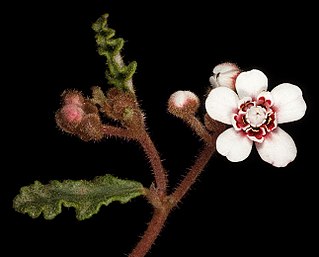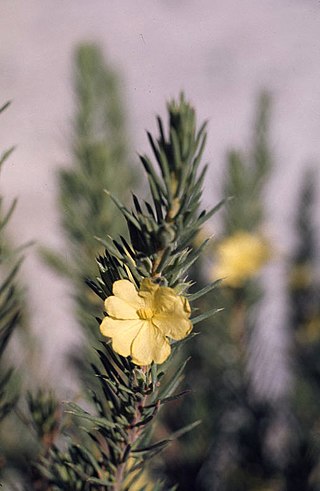
Calytrix depressa is a species of flowering plant in the myrtle family Myrtaceae and is endemic to the south-west of Western Australia. It is a glabrous shrub with linear to lance-shaped leaves and mauve to violet or yellow flowers with 35 to 75 stamens in several rows.

Thomasia sarotes is a species of flowering plant in the family Malvaceae. It is an upright, spreading shrub with purple, pink to mauve or white flowers and is endemic to the south-west of Western Australia.

Thomasia pygmaea, commonly known as tiny thomasia, is a species of flowering plant in the family Malvaceae and is endemic to southern Western Australia. It is a low, dense, compact shrub with broadly heart-shaped to egg-shaped or more or less round leaves and pink to purple flowers.

Lysiosepalum involucratum is a species of flowering plant in the family Malvaceae and is endemic to the south-west of Western Australia. It is dense, compact or spreading shrub with its young branches covered with woolly, star-shaped hairs, and has narrowly egg-shaped leaves and purple flowers usually in groups of 2 to 6.

Guichenotia macrantha, commonly known as large-flowered guichenotia, is a species of flowering plant in the family Malvaceae. It is a shrub with grey-green leaves, mauve flowers and is endemic to Western Australia.

Hemiphora uncinata is a flowering plant in the mint family Lamiaceae and is endemic to the south-west of Western Australia. It is an erect, spreading shrub with its branches densely covered with white, woolly hairs. Its leaves are rough and wrinkled and the flowers are tube-shaped with deep pink petals with wavy edges.

Androcalva pulchella is a species of flowering plant in the family Malvaceae and is endemic to the south-west of Western Australia. It is a small shrub with egg-shaped, elliptic or oblong leaves, the edges wavy, lobed or toothed, and clusters of two to seven white and deep pink flowers.

Hibbertia mucronata is a species of flowering plant in the family Dilleniaceae and is endemic to the south of Western Australia. It is an erect shrub with hairy branches, crowded, thick, tapering linear leaves ending in a sharp point, and golden yellow flowers with five stamens fused at their bases, all on one side of two densely hairy carpels.
Bossiaea divaricata is a species of flowering plant in the family Fabaceae and is endemic to the southwest of Western Australia. It is a low, dense, openly-branched shrub with oblong to egg-shaped leaves and deep yellow and dark red flowers.

Daviesia crenulata is a species of flowering plant in the family Fabaceae and is endemic to the south-west of Western Australia. It is a bushy shrub with broadly egg-shaped phyllodes with a sharply-pointed end and wavy edges, and uniformly yellow-orange and maroon flowers.

Lasiopetalum quinquenervium is a species of flowering plant in the family Malvaceae and is endemic to the south of Western Australia. It is an erect, spreading shrub with hairy stems and leaves, egg-shaped leaves and pink or white flowers.

Lasiopetalum rosmarinifolium is a species of flowering plant in the family Malvaceae and is endemic to the south-west of Western Australia. It is an erect or spreading shrub with hairy stems and leaves, linear leaves and white flowers.

Thomasia brachystachys is a species of flowering plant in the family Malvaceae and is endemic to the Southwest Australia south-west of Western Australia. It is an open, erect shrub with egg-shaped to heart-shaped leaves and pink to mauve flowers.

Thomasia rhynchocarpa is a species of flowering plant in the family Malvaceae and is endemic to the Southwest Australia south-west of Western Australia. It is an erect, slender shrub with narrowly egg-shaped leaves with a heart-shaped base, and pink to purple flowers.

Thomasia stelligera is a species of flowering plant in the family Malvaceae and is endemic to the south-west of Western Australia. It is a low, spreading shrub with scattered, narrowly oblong leaves, and racemes of mauve flowers.
Androcalva cuneata is a species of flowering plant in the family Malvaceae and is endemic to the south-west of Western Australia. It is a low, spreading, densely hairy shrub that sometimes forms suckers and has wedge-shaped leaves and clusters of 5 to 15 pink flowers.

Commersonia densiflora is a species of flowering plant in the family Malvaceae and endemic to the south-west of Western Australia. It is a dense, low-growing shrub with pinnate, elliptic to narrowly oblong, prominently veined leaves, and white flowers in clusters of 100 or more.
Commersonia rotundifolia, commonly known as round-leaved rulingia, is a species of flowering plant in the family Malvaceae and endemic to the south-west of Western Australia. It is an upright, openly-branched shrub with elliptic to round leaves with wavy edges, and white flowers in clusters of 3 to 10.

Androcalva crispa, commonly known as crisped leaf commersonia, is a species of flowering plant in the family Malvaceae and is endemic to the south-west of Western Australia. It is a prostrate shrub that forms suckers from rhizomes and has densely new growth, clusters of lobed, egg-shaped or oblong leaves with wavy, serrated edges, and groups of white and pinkish-purple flowers.

Guichenotia angustifolia is a species of flowering plant in the family Malvaceae and is endemic to the south-west of Western Australia. It is an erect, prostrate or climbing shrub with hairy young growth, hairy, oblong to linear leaves and pink to mauve flowers.


















